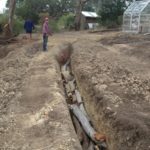Well if you haven’t heard of Hugelkultur, then you really should read this.
As you “permies” know, a lot of the concepts of permaculture evolved around the observation of nature. When I did a permaculture practical course with Bill Mollison et al, we were sent off into the Tasmanian forest to observe ancient forests. This was quite the eye-opener to me. The forest floor was like walking on a gigantic SPONGE. So soft and moist in the heat of the summer. Several degrees cooler than surrounding farmland. Freshwater lobster tunnels! Yes, they burrow into the ground as they follow the water table.
The very next day, we dug a swale on Bill’s property and this was after some decent rain. In stark contrast to the forest we’d seen only a few kilometers away, the ground was DRY only a few millimeters beneath the surface. Well, that’s what happens when you have a hard-packed surface… the rain just stays on the surface and washes downhill.. about 87% of the rainwater ends up in the ocean!
So my good buddy Greg Knibbs recently told me about Hugelkultur and I was kicking myself, because I’d just done my garden beds. I started reading…
Basically, the concept is that you take a bunch of timber (about 1 meter to 2 meters deep) and cover it with soil. It is like a mega-compost. As the wood decays, it becomes a host for fungi and other microbes and also starts acting like a massive sponge. In essence, it becomes a model version of a forest floor. It also means you have the ability to be more drought tolerant, and many people have claimed to no longer need to water their trees or other plants during the summer. Very intriguing to me as we just experienced the driest summer on record here in Victoria.
So we have started the experiment– two 6 meter rows at 1 meter deep have been excavated for our orchard. In between, there is a ripline which is intended as a comparison, and a swale is immediately uphill to capture and soak in the big rains which come during the winter.
We have begun stacking tree trunks, branches, and leaves into the pits and soon we’ll be backfilling the entire area with compost, manure and topsoil. It is literally a gigantic compost heap!
Stay tuned as we continue the experiment.
